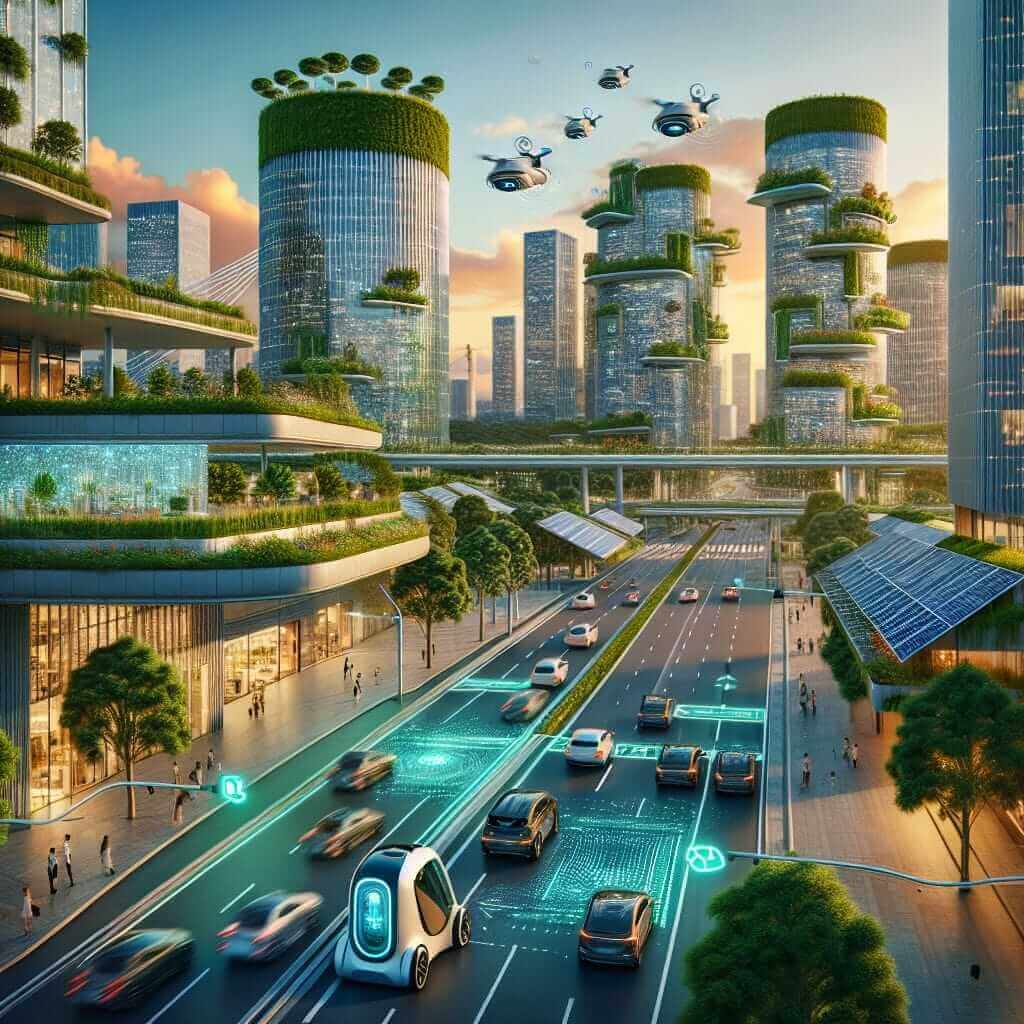The IELTS Reading section tests your ability to interpret, comprehend, and analyze texts. One such prevalent topic is urban sustainability – a subject gaining traction due to its relevance in modern world issues. “How is AI being used to enhance urban sustainability?” is a key phrase often explored, reflecting the importance of technology in sustainable urban development. Given its timeliness and frequent appearances, this subject may likely reappear in future IELTS exams.
Reading Passage: Enhancing Urban Sustainability with AI
The Complete Text (Medium Text)
Artificial Intelligence (AI) holds enormous potential to enhance urban sustainability. As cities worldwide grapple with issues such as pollution, inefficient energy use, and congested infrastructure, AI stands as a solution to these pressing problems.
AI-driven technologies have been deployed in various sectors. One notable application is in traffic management systems. Machine learning algorithms can predict traffic patterns and adjust traffic signals dynamically, reducing congestion and lowering emissions. For example, Google’s DeepMind AI was employed in Tokyo to optimize traffic flow, which led to a 10% reduction in travel time.

Energy consumption is another critical domain where AI can contribute. Predictive analytics can optimize energy usage in buildings by learning patterns from historical data, thus making intelligent decisions about heating, air conditioning, and lighting. This not only reduces energy costs but also diminishes the carbon footprint. IBM’s Green Horizon project in China leverages AI to forecast air pollution and propose mitigation strategies, showcasing how technology can tangibly improve urban air quality.
Waste management is another sector benefiting from AI. AI systems can sort recyclable materials more accurately than human labor, making recycling processes more efficient. Additionally, AI can predict waste production levels, enabling better planning and resource allocation.
Moreover, AI is pivotal in creating smarter public transportation systems. Algorithms can optimize routes for buses and trains, ensuring that they run as efficiently as possible. For instance, the city of Los Angeles has integrated AI in its public transport network to minimize delays and enhance service reliability.
Despite these advancements, several challenges remain. The implementation of AI requires significant investment and there’s a steep learning curve involved. Privacy concerns also arise because AI systems often require large data sets to function effectively. Nevertheless, the continued development and application of AI promise substantial improvements in urban sustainability, making cities more livable and environmentally friendly.
Questions
Multiple Choice
-
What is one of the primary benefits of using AI in traffic management?
- A. Decreasing air pollution
- B. Increasing vehicle speeds
- C. Offering free public transportation
- D. Repairing damaged roads
-
The IBM’s Green Horizon project in China primarily focuses on:
- A. Improving healthcare facilities.
- B. Forecasting air pollution.
- C. Enhancing educational systems.
- D. Reducing poverty levels.
Identifying Information (True/False/Not Given)
-
AI can only be applied to traffic management in urban sustainability.
- True
- False
- Not Given
-
The city of Los Angeles uses AI to minimize public transport delays.
- True
- False
- Not Given
Matching Headings
- Match the paragraph with the heading that best fits.
- A. AI in Traffic Management
- B. AI and Energy Consumption
- C. AI’s Role in Waste Management
- D. Challenges in Implementing AI
- E. AI in Public Transportation
Answers with Explanations
- A. Decreasing air pollution. The text specifies that AI in traffic management reduces congestion and emissions, leading to decreased air pollution.
- B. Forecasting air pollution. The IBM’s Green Horizon project is mentioned as using AI to predict air pollution and propose solutions.
- False. The passage details several areas, including traffic management, energy consumption, waste management, and public transportation, where AI is applied.
- True. It is stated that Los Angeles integrates AI in its public transport to minimize delays.
- Paragraph Matching:
- A. AI in Traffic Management corresponds to the first instance where traffic systems are discussed.
- B. AI and Energy Consumption relates to mentions of energy optimization in buildings.
- C. AI’s Role in Waste Management links to the discussion on recycling and waste prediction.
- D. Challenges in Implementing AI is related to the mention of investment and data privacy concerns.
- E. AI in Public Transportation ties to improving public transport systems.
Common Mistakes
- Misinterpreting Vocabulary: Misunderstanding specific terms like “predictive analytics” can lead to incorrect answers.
- Overlooking Key Details: Skimming the passage too quickly might result in missing critical points, such as exact purposes of projects or specific benefits of AI applications.
Vocabulary
- Predictive Analytics (n): /prɪˈdɪktɪv əˈnælɪtɪks/ – The practice of extracting information from existing data sets to predict future occurrences.
- Carbon Footprint (n): /ˈkɑːrbən ˈfʊtˌprɪnt/ – The total amount of greenhouse gases generated by our actions.
- Mitigation (n): /ˌmɪtɪˈɡeɪʃən/ – The action of reducing the severity or seriousness of something.
Grammar Focus
- Present Perfect Tense: Used to describe actions that occurred at an unspecified time, relevant to now (e.g., “AI-driven technologies have been deployed”).
- Passive Voice: Often used in academic writing to emphasize actions over doers (e.g., “AI systems can be sorted”).
Tips and Strategies
- Practice Regularly: Consistent practice with varied reading passages strengthens comprehension skills.
- Use Context Clues: Rely on the context to infer the meanings of unfamiliar words or phrases.
- Review Grammar Rules: A solid grasp of grammar aids in understanding complex sentence structures in reading passages.
By incorporating AI for urban sustainability into your IELTS preparation, you not only stay current on important issues but also enhance your chances of scoring high in the Reading section.